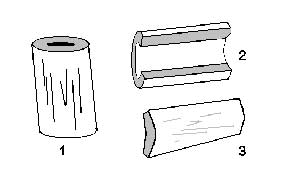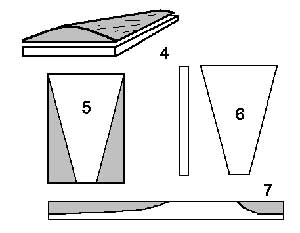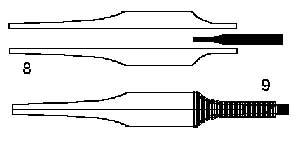Cane selected for chanter reeds is about one inch in diameter. The walls of the cane are about 3/16 to ¼ inch thick. Eight inch lengths are split in half and shortened to two inch lengths.
The inside surface of these short lengths are now planed to produce a slight radius. This is done manually or otherwise on a specially built planer. This produces the finished inside surface of the reed. This "blank" is then placed into a cutting block and the vertical sides of the reed are cut. All cutting tools are extremely sharp so that the cut will not otherwise damage the cane fibers. The next step is to cut the outside horizontal surface. This removes the bark of the cane and leaves us with a reed blank that is roughly the size and shape of the finished product. Because we have already finished the inside surface of the blank to have a slight radius, the outside surface must be cut while the blank is held flat. Otherwise the reed will be thin in the center and thick along each edge.
Up to this stage of production, the blades can be mass produced and stored almost indefinitely, provided they are kept in a stable environment. They are still quite hardy and able to withstand normal handling and storage. The next step is quite another story. The blades and the neck are
both cut to a finished thickness by means of a precision cutting machine. This leaves the blades very delicate and subject to damage.
After soaking the necks of the blades in water for about ten minutes, (the water is actually absorbed up into the body of the blade) the blades are tied onto a copper tube called a staple. The staple is tubular at one end and flattened into an oval shape at what will be the top end.
Now we have a pretty rough reed. The blades are long at this point and will be finished to about 16mm above the hemp line in a couple of days. This settling of two or three days is necessary to ensure the reed forms properly as it dries. Remember, it was tied onto the staple when wet. Before finishing, the reeds are carefully inspected to ensure that no splitting has occurred during the drying period. The reeds are finished to the maker's standards and the blades are shortened to finished length.
The inside surface of these short lengths are now planed to produce a slight radius. This is done manually or otherwise on a specially built planer. This produces the finished inside surface of the reed. This "blank" is then placed into a cutting block and the vertical sides of the reed are cut. All cutting tools are extremely sharp so that the cut will not otherwise damage the cane fibers. The next step is to cut the outside horizontal surface. This removes the bark of the cane and leaves us with a reed blank that is roughly the size and shape of the finished product. Because we have already finished the inside surface of the blank to have a slight radius, the outside surface must be cut while the blank is held flat. Otherwise the reed will be thin in the center and thick along each edge.
Up to this stage of production, the blades can be mass produced and stored almost indefinitely, provided they are kept in a stable environment. They are still quite hardy and able to withstand normal handling and storage. The next step is quite another story. The blades and the neck are
both cut to a finished thickness by means of a precision cutting machine. This leaves the blades very delicate and subject to damage.
After soaking the necks of the blades in water for about ten minutes, (the water is actually absorbed up into the body of the blade) the blades are tied onto a copper tube called a staple. The staple is tubular at one end and flattened into an oval shape at what will be the top end.
Now we have a pretty rough reed. The blades are long at this point and will be finished to about 16mm above the hemp line in a couple of days. This settling of two or three days is necessary to ensure the reed forms properly as it dries. Remember, it was tied onto the staple when wet. Before finishing, the reeds are carefully inspected to ensure that no splitting has occurred during the drying period. The reeds are finished to the maker's standards and the blades are shortened to finished length.
The bagpipe chanter reed is perhaps the single largest source of frustration for a piper. New reeds are usually difficult to blow and can make blowing your bagpipe a physically and emotionally draining experience. All reeds weaken after an initial "blowing in" period. Some pipers, however, try to avoid the process by selecting weaker reeds or hasten the process by performing "rites of passage" on the reed.
Spanish cane, (Arundo dowax) grown in the Mediterranean region, is cut and sun cured to produce a dry, hard cane product. Reed makers try to select cane that is relatively close-grained and very hard.
Spanish cane, (Arundo dowax) grown in the Mediterranean region, is cut and sun cured to produce a dry, hard cane product. Reed makers try to select cane that is relatively close-grained and very hard.
Chanter Reeds




